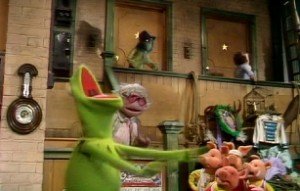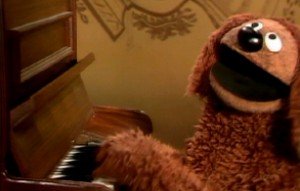The Muppet Show 1.07: “Florence Henderson”
Significantly, however, whereas other characters tend to get taken aback and fall in line when Kermit truly goes off the deep end, Piggy is the only one who doesn’t. He basically can’t defeat her, because every single action he takes only makes her love him more. His yelling only ignites her passion further, as we see here and near the end of the episode, after she asks him how he and “Miss Henderson” are getting along, clearly seething with jealous. Now, this doesn’t fully track with the fact that she didn’t seem concerned about this in the previous scene, even though it happened after she “caught” them together, but, again, the show is still finding its way when it comes to internal continuity. But putting that aside, her first response to Kermit is, “Jealous? Moi?!,” marking the first instance of Piggy pretending to be able to speak French, another important aspect of her character falling into place. Then Piggy claims that, actually, she’s “just glad that other women find my frog attactive,” demonstrating her ability to save face or to at least try to, and then when Kermit insists that he’s not her frog, she again plays up her “cultured” facade by paraphrasing Shakespeare, “Methinks thou doth protest too much!”
And so she continues to maintain that Kermit’s disavowals of his “feelings” for her don’t faze her. That doesn’t mean, however, that she would allow that to be to the detriment of her own self-respect. When he goes too far, following up on her telling him that it’s Shakespeare with “Sounds more like Bacon from a ham…,” a burn that’s also a reference to the earlier debate topic, which she had perceived to be a cruel mockery of her species–yet another running thread in this episode, making it easily the most complexly structured yet–Piggy finally karate chops him into submission, maintaining her dignity all the while. When she’s done, she turns to the camera saying, “You always hurt the one you love.” In essence, this is the Kermit/Piggy relationship on The Muppet Show in microcosm–it will shift in the films, which are likely seen more often today (the last two seasons of the show aren’t even legally available or currently airing today), but this episode really sets the tone for the next 4 1/2 years of the television series. She loves Kermit and has essentially created a relationship with him in her head but also won’t broach any insults from him. Meanwhile, Kermit’s just along for the ride.
Other moments of note:
–I’m particularly fond of this exchange from the rat couple in this week’s “At the Dance”. The male rat says, “I think we oughtta move out of the ghetto and find a nice little dump in the suburbs”. His partner’s response? “Oh, honey, I love you like the plague!”
–Rowlf’s piano number this week is “Cottleston Pie,” a sweet nonsense song that was written by A. A. Milne and can be found in his classic children’s novel, Winnie-the-Pooh. This is the second Milne song featured on the show, after Robin’s “Halfway Down the Stairs”. This song likely would have been very recognizable to audiences in England, where The Muppet Show was filmed, and indeed, this sequence didn’t originally air in the U.S. Due to longer commercial breaks, every single Muppet Show episode contained one scene, usually a song, that the U.S. didn’t get in the original airings. I particularly love here how Rowlf modulates in the second verse, and explains to the audience what that means when he does. In these piano bits, Rowlf always felt like he was talking directly to the home audience, making them complicit in his act.
–It seems like practically every week, Fozzie introduces a different twist to his act, due to The Muppet Show writers continuing to experiment with his character. This week, he decides to do celebrity impersonations, the Fozzie-ish twist being that all of them sound exactly alike, and they all sound exactly like Fozzie! “All your impressions sound the same!” Waldorf calls. Fozzie’s actually rather brilliant response is, “I can’t help that! They were all written by the same writer!” And at the end, he continues to demonstrate his new propensity for getting the upper hand against those two when ask him to do an impression of leaving the stage, which he does for a moment, then pops back up to say he made it a “bare stage”. Bear/bare, get it?! “I love me!” he cries in ecstacy as he leaves. “I’m too good for this show!”
–The only significantly odd thing about this episode is that “Happy Together,” although it feels like a climactic finale that should be at the end of the show, isn’t. Instead, after it’s done, there are still four more scenes, making the end of the episode feel a bit unbalanced: (1) the aforementioned Kermit/Piggy “Bacon” scene; (2) a sweet little scene in which Sweetums “falls” for Henderson…literally; (3) a sketch set on the alien planet, Koozebane; and (4) the curtain call.
The Koozebane sketch is a direct remake of the very same one on the Koozebanean mating ritual which they featured on The Muppets Valentine Show, and, while it’s just as wonderful there as it is here, I don’t really have much to add about its content since it’s pretty much identical (other than the fact that two lovers whose passion destroys each other is an interesting parallel to an episode about Piggy’s lust for Kermit!). I will say, though, that it is another example of The Muppet Show‘s ambiguity over its internal reality. Is Kermit “really” supposed to be on an alien planet, reporting on its inhabitants, or is this simply a sketch? And, if so, are these actual Koozebaneans or “actors”? If the former, did they really just mate/explode on camera? If the latter, did the “actors” really just explode?
Not that the actual answers are important but it’s just meant to show that, while The Muppet Show had a “real world” framework, it could often be a very loose one, and Jim Henson and Co. wouldn’t allow it to limit their imaginations. The internal reality of the “on-stage” sketches shifted based on the demands of any given sketch. I’ll probably have much more to say about this when we get to one of the episodes where this is even more directly confronted, such as when an otherwise seemingly “real” sketch is interrupted by off-stage antics, or when something that occurs on-stage seems to still be affecting the “actors” off-stage.
So, all in all, a significant leap forwards for The Muppet Show in terms of character development and script complexity, and bolstered by a terrific guest appearance by a much-beloved and only recently dearly departed TV icon. That isn’t to say that it’s smooth sailing from this point forwards for the show. There will definitely be regressions in the coming weeks, but the example set by this installment certainly has long-term effects on the series’ overall future path.
Next time: Paul Williams, who would write many beloved Muppet songs further down the line!



